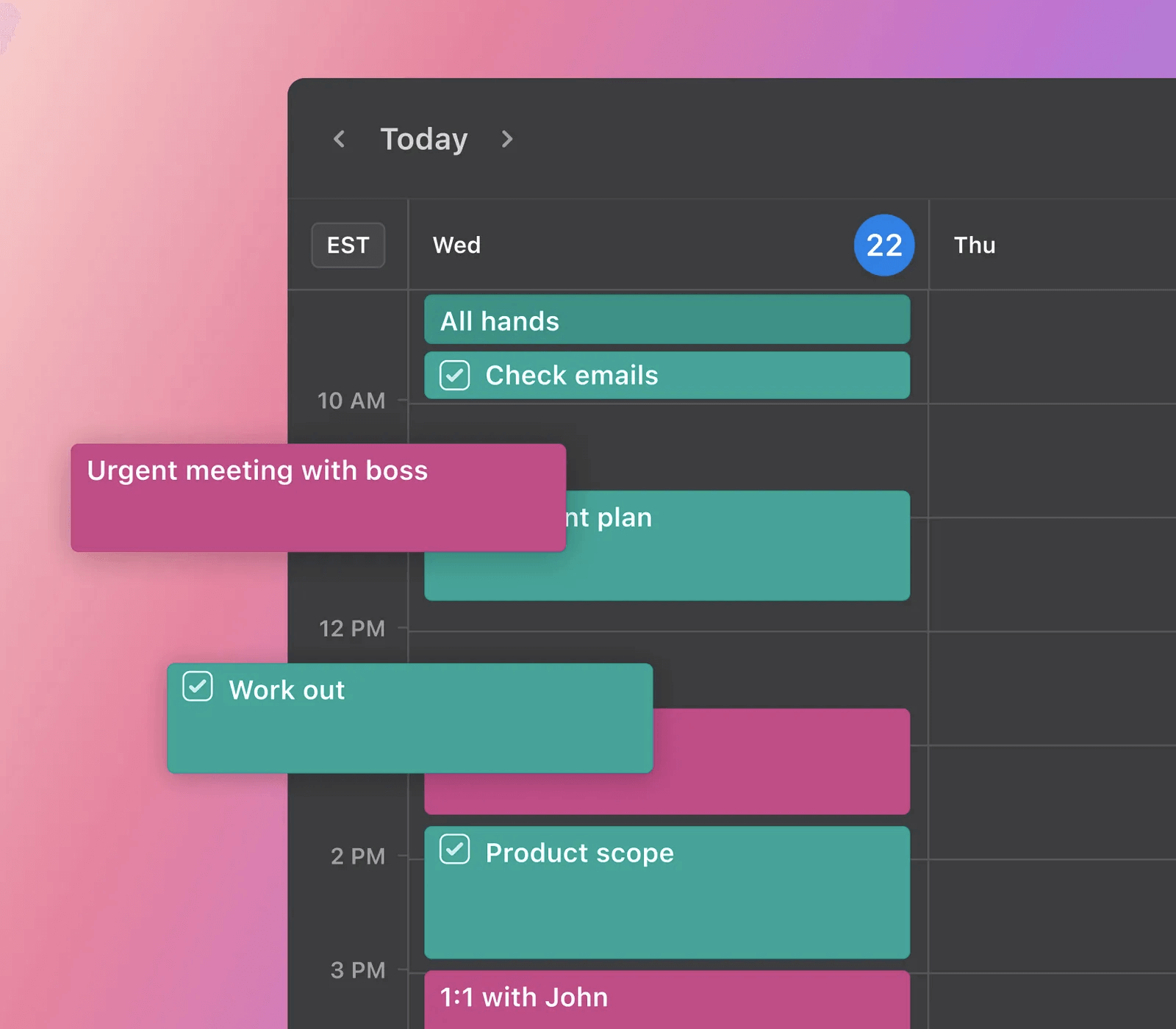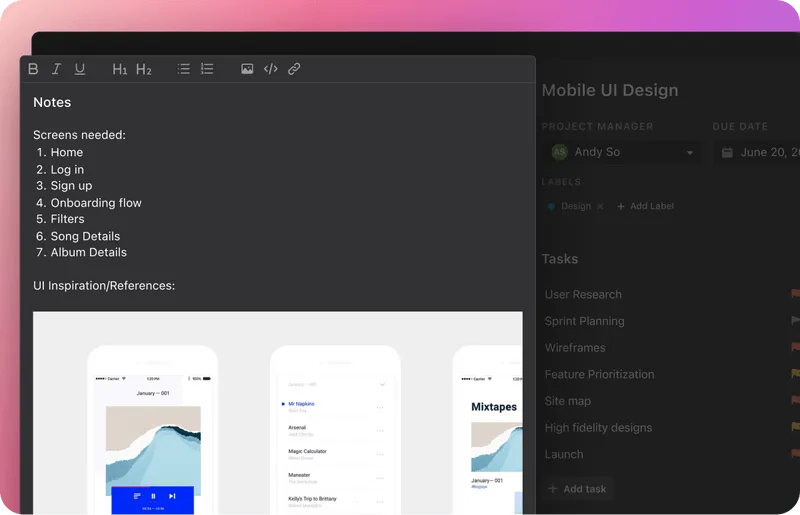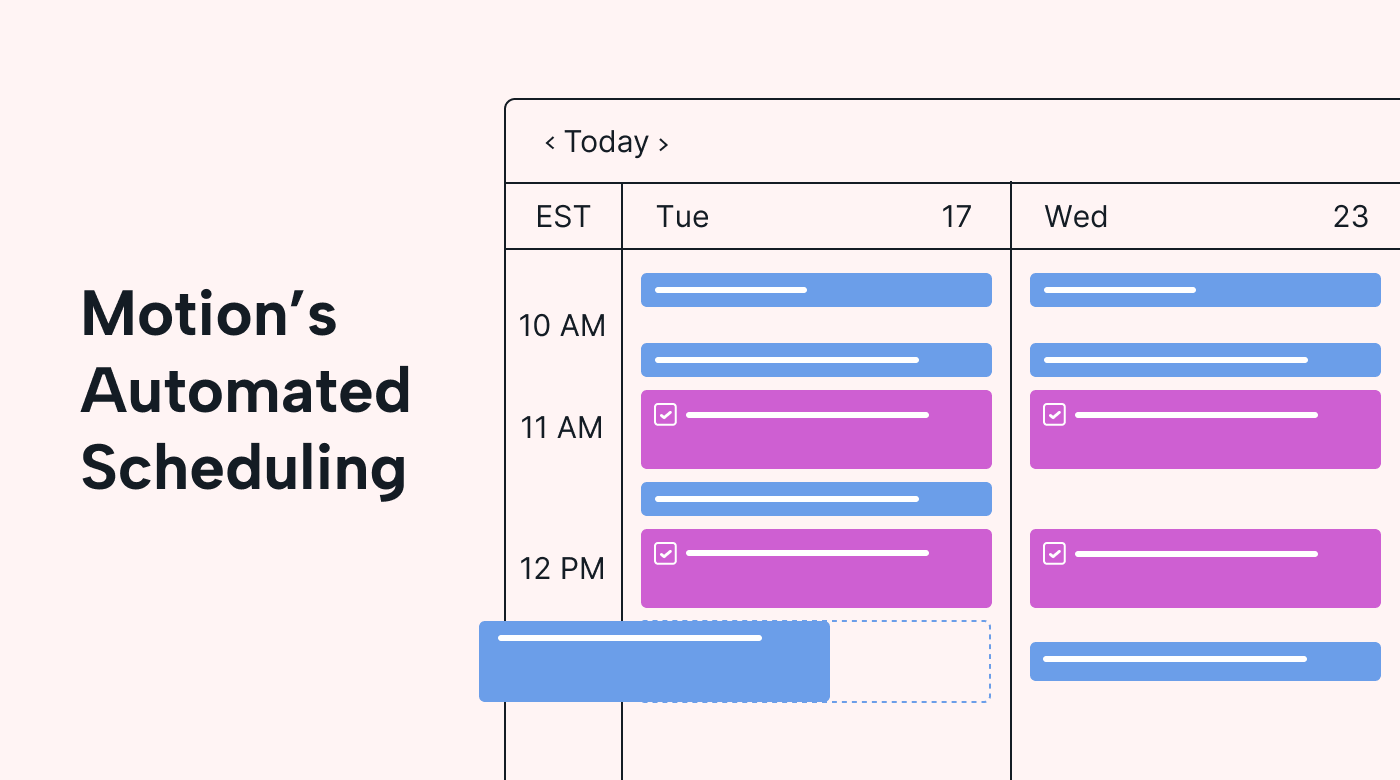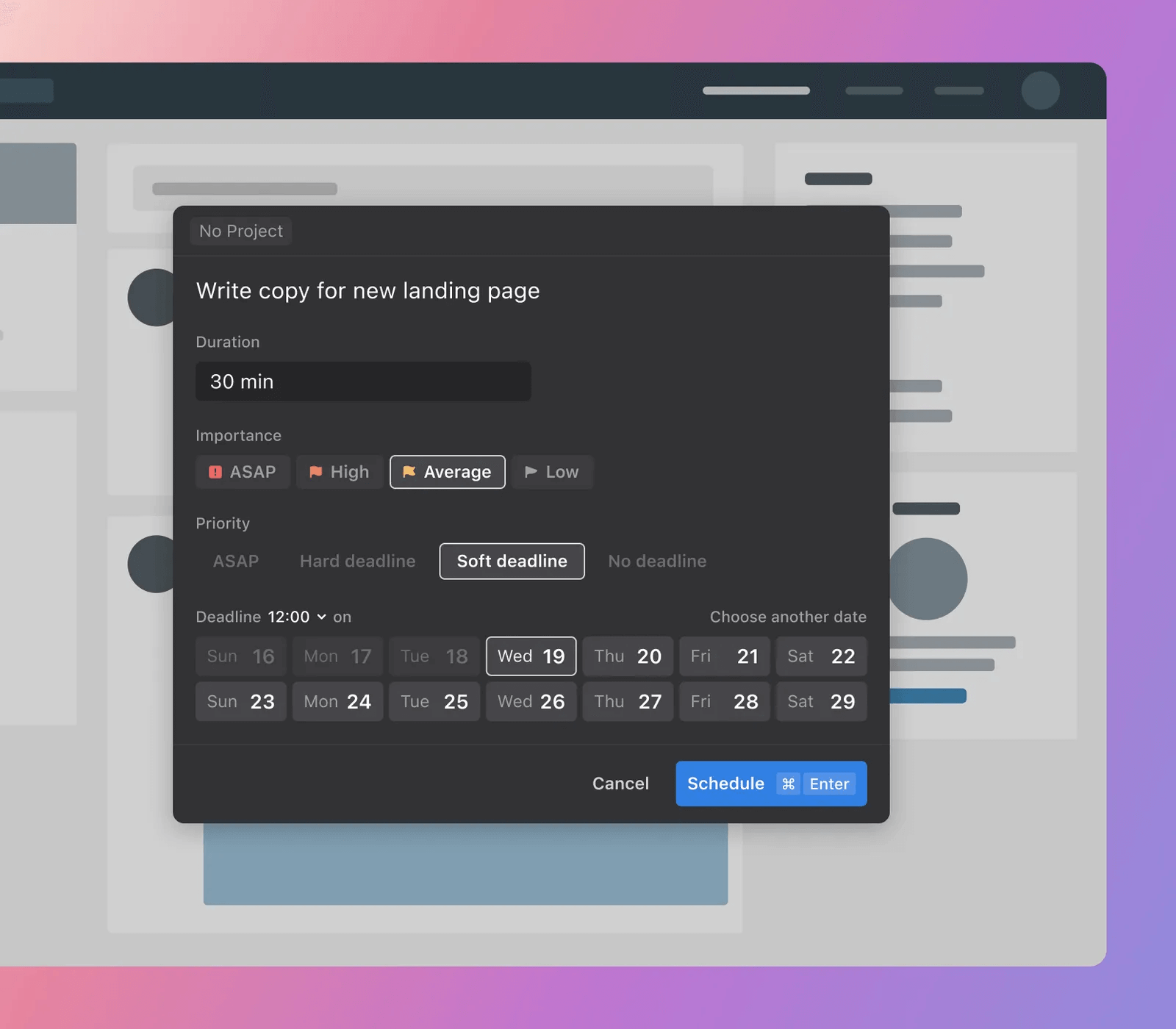Virtual work is a phrase that’s thrown around a lot, but it’s not always understood. In fact, most people refer to virtual work in the same way they talk about remote work.
Spoiler alert — they’re not the same thing.
If you want to find out what virtual work is and how to use it effectively, you’ve come to the right place. In this article, we’ll define what virtual work is, the difference between remote and virtual work, and offer some advice on how to successfully use virtual work in your business.
What is virtual work?
Virtual work is a term that describes using technology and digital tools to perform work tasks. It also focuses on how to use technology effectively to communicate with colleagues and manage your workload.
For example, using a tool like Motion to manage and streamline your workflow is part of virtual work.
 |
With a virtual work environment, businesses can make sure that employees have access to the best technology for their needs. As a result, communication can be improved, productivity can get a boost, and businesses can grow at a faster rate.
What’s the difference between remote and virtual work?
Although the phrases are often used interchangeably, virtual work and remote work aren’t the same.
Remote work focuses on location. In other words, if an employee is working remotely, they’re working from a place other than the office. Virtual work, on the other hand, focuses on how to use technology and digital tools to perform work tasks as efficiently as possible.
 |
Let’s look at the differences in more detail.
- Remote work: Remote work generally refers to a work arrangement where employees perform their job responsibilities outside of the traditional office setting. Remote work includes various setups, such as working from home, co-working spaces, coffee shops, or any other location that isn't your central office. The emphasis is on the physical distance between the employee and the office, with remote workers relying on technology for effective communication and collaboration.
- Virtual work: Virtual work specifically highlights the use of technology and digital tools to perform work tasks and collaborate with colleagues. It involves online meetings, virtual collaboration, and using project management tools or cloud-based platforms. It’s an important aspect of remote work because efficient virtual work makes it easier for teams to collaborate remotely (more on this later).
What are the benefits of virtual work?
Now that we know what virtual work is (and how it’s different from remote work) let’s look at the benefits of using virtual work in your business.
- To improve communication for remote teams. Virtual work focuses on using the best modes of communication to help remote teams work as efficiently as possible. As a result, remote team collaboration becomes easier. Think about video calls (like Zoom meetings) or instant messaging as an example. With these digital platforms in place, teams can easily keep in touch in real-time, regardless of physical location.
- To maximize efficiency. Virtual work helps teams find the most efficient ways to collaborate digitally. This means teams can improve their workflow, boost productivity, and maximize their time for the best results. In other words, it helps them be more efficient with their work.
- To establish clear communication channels. When you prioritize virtual work, you spend time identifying the best communication channels for your team. In doing so, you show your team members how to clearly communicate with each other using these platforms. There’s no confusion over how to contact anyone because all this information is clear to the entire team.
- To make it easier to scale your business. Virtual work processes make it easier for businesses to change, adapt, and grow their existing business processes. Let’s say that your business is growing at a fast pace. With virtual work platforms, it’s easier for you and your growing team to keep up with the growth and adapt the software to meet your changing needs. Take a look at Motion as an example. You can start using our individual account but upgrade to our team account if your business starts to grow.
How to use virtual work effectively
Follow these steps to implement an effective virtual work culture for you and your team.
Create clear guidelines
The first step is to establish clear guidelines and expectations for using the technology and communication channels you’ve implemented.
For example, you could have a communications guide that shows everyone in your team what communication channels to use, how they work, and who to contact for certain information. That way, everyone knows what platforms to use, how to use them, and who to contact.
Here are a couple of top tips for setting clear guidelines for your virtual work channels and processes:
- Use a collaborative platform to store and share your guidelines. Make it easy for your team to access the guidelines by storing them in a central, easily accessible location. A cloud-based platform like Motion is a good example. You can add your guidelines to the system, allowing everyone to instantly access the most up-to-date information.
 |
- Define communication expectations. In your guidelines, clearly define what communication channels you use as part of your virtual work. For example, email, instant messaging, or video conferencing. You’ll also need to explain what types of communication these platforms are used for and set expectations for response times (including when timely responses are required and when a delayed response is acceptable).
Provide training and support
For virtual work to be successful, everyone needs to know how to use the software, communication channels, and processes.
This is where training and support comes into play.
With regular training, your team will be up to speed on the best practices for all your virtual tools and platforms. They’ll be confident in how they work, what they’re used for, and how to use them.
Take a look at these best practices for training and supporting your team:
- Assess training needs. Start by identifying the training needs of your team members. This involves understanding their current skill levels, familiarity with the tools, and specific requirements for their roles. Then, you can make sure they receive the right training for the right tools.
- Offer hands-on practice. Provide opportunities for team members to practice using the virtual tools in a safe environment. Encourage them to explore different features and perform tasks relevant to their roles. This will help build their confidence and reinforce their learning.
- Provide team members with software updates. Keep your team members informed about updates, new features, or any changes to the virtual tools. That way, everyone can use the tools as effectively as possible. You can also encourage team members to share their experiences, tips, and best practices for other people to use.
- Document your resources. Create a centralized location to store all your training and resources for your virtual tools. This will be a reference for team members to access key information and find solutions to common issues.
- Gather feedback from team members. To figure out where your team needs more support or training, ask them for feedback. If the same areas of confusion or hurdles keep cropping up, you should offer training or support to help your team overcome these challenges. You can also seek feedback from team members regarding their training experiences. Use their feedback to continuously improve training programs and identify areas where additional support or resources may be required.
Encourage regular feedback
We’ve just mentioned how gathering feedback can help you train and support your teams. Well, their feedback can also help you determine the effectiveness of your virtual tools. After all, they’re the ones using the software regularly.
So how can you encourage regular feedback with your team?
Here are a couple of suggestions:
- Show team members that you want their feedback: As a leader or manager, it’s helpful to show team members that you’re receptive to their input. This means actively listening to their suggestions and making changes where necessary. When team members see that their feedback is welcomed and acted upon, they’re more likely to provide it!
- Host regular catch-ups. Plan regular catch-up meetings with your team so they have a chance to provide feedback or ask questions. It’s up to you how often you run the catch-ups and how long they’ll last (after the first catch-up, you’ll have a better idea of how long they should be and how often they should take place). You can use Motion’s meeting assistant to easily schedule recurring virtual meetings with your team. Or, you can set a recurring reminder in your calendar for colleagues to share their feedback with you.
 |
- Create an online form. Give your team members access to an online form where they can submit their feedback and queries for your perusal. This means they can upload information at any time for you to review.
Continually test and try new software
It’s no secret that technology is constantly developing. There’s new software hitting the scene all the time, which means there could be new platforms out there that are better suited to what you need.
By keeping your ears to the ground and trialing new software, you give yourself a good chance of finding a platform that’ll improve the efficiency of your work.
For example, if you use a regular calendar to plan and manage your work, you might consider upgrading to an AI-powered calendar like Motion.
With our platform, you can automatically schedule tasks without manually moving things around. These features help you improve your processes and streamline the efficiency of your work, which is the whole point of virtual work.
 |
Part of this process also involves testing your existing software to find areas of improvement. If things aren’t working as well as you’d like, you might want to upgrade to another platform.
Here are some ways to review the performance of your virtual work tools:
- Review feedback. We’ve already touched upon the importance of feedback when it comes to virtual work tools, and it’s no different here. Use feedback from team members to pinpoint areas of improvement or gaps in your processes that could be filled by implementing a new tool.
- Use analytics. Have a look at the usage analytics of your virtual work tools. Platforms have different analytic features but try to find information that shows how often your team uses the tools and what they’re using them for. If they’re not using them often or not using them for the reason you intended, you might want to try a different tool.
- Analyze cost vs. value. Consider the price of the virtual work tools you use and the value they offer your business. Do the benefits they provide justify the cost? Or is another tool out there offering better features for a similar or lower price?
Use Motion to manage your virtual work processes
Virtual work can benefit any business, but it’s an ongoing process to keep it running smoothly.
You need to constantly review your processes and technology and ensure that everything improves efficiency as much as possible. If not, you’ll need to review your current tech and see if there’s a better fit out there.
If you’re looking for a tool to streamline your workload management, use Motion’s AI-powered calendar. With our platform, you can easily add tasks to your calendar, share updates with your team, and reshuffle tasks in a matter of clicks.
Plus, you can always make sure that your most important tasks take priority over other work in your schedule. Sign up for a free trial to get started.





